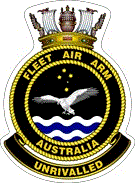Fleet Air Arm (RAN)
| Fleet Air Arm | |
|---|---|
 |
|
| Founded | 3 July 1947 |
| Country |
|
| Type | Naval Aviation |
| Part of | Royal Australian Navy |
| Airbase | NAS Nowra |
| Motto(s) | Unrivalled |
| Website | Royal Australian Navy – Fleet Air Arm |
| Commanders | |
| Commander, Fleet Air Arm | Commodore Chris Smallhorn |
| Insignia | |
| Roundels |
 
|
| White Ensign | |
| Aircraft flown | |
| Attack | S-70 Seahawk |
| Trainer |
Eurocopter Squirrel Bell 429 |
| Transport | MRH-90 Taipan |
The Fleet Air Arm (FAA), known formally as the Australian Navy Aviation Group, is the division of the Royal Australian Navy (RAN) responsible for the operation of aircraft. The FAA was founded in 1947 following the purchase of two aircraft carriers from the Royal Navy. FAA personnel fought in the Korean War (operating from the carrier HMAS Sydney) and the Vietnam War (attached to a Royal Australian Air Force squadron and a United States Army Aviation company), and participated in later conflicts and operations from host warships.
Initially operating only fixed-wing aircraft, helicopters were first acquired by the FAA in 1952, forming Australia's first helicopter squadron. Helicopter usage increased over time, particularly after 1982, when the carrier HMAS Melbourne was decommissioned and not replaced. In 2000, following the removal from service of the land-based Hawker Siddeley HS 748 aircraft, the FAA became an all-helicopter force, operating in the anti-submarine warfare and maritime support roles. As of 2011, the FAA consists of three active squadrons, operating four helicopter types.
During the 1920s, the RAN attempted to acquire government support for an Australian Fleet Air Arm, modelled loosely on the Royal Naval Air Service and its Royal Air Force-controlled successor, the Fleet Air Arm. This was approved as part of improvements to Australia's military, but opposition by the Royal Australian Air Force (RAAF) prompted the Cabinet to disband the organisation in January 1928, shortly after its establishment. The RAAF assumed responsibility for naval aviation, which consisted primarily of amphibious aircraft flown by No. 101 Flight RAAF (and its successors, No. 5 Squadron, then No. 9 Squadron) from the RAN's cruisers and the seaplane tender HMAS Albatross.
...
Wikipedia

